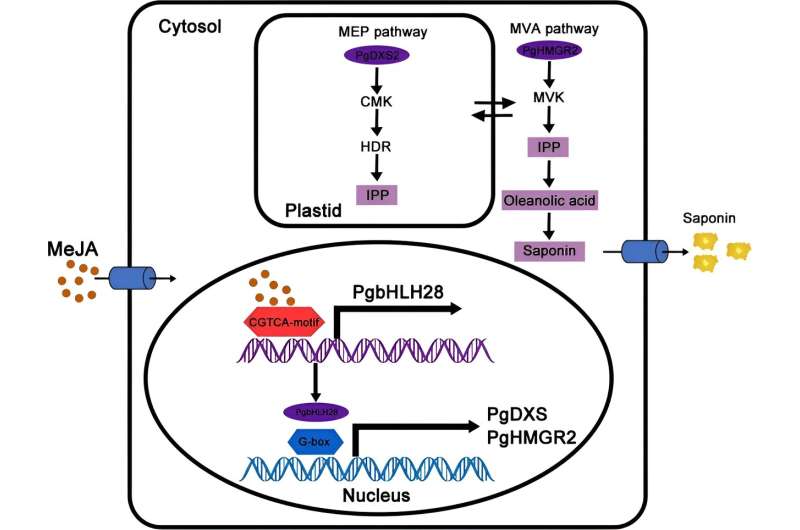This article has been reviewed according to Science X's editorial process and policies. Editors have highlighted the following attributes while ensuring the content's credibility:
fact-checked
peer-reviewed publication
proofread
New insights into methyl jasmonate-induced saponin biosynthesis in the balloon flower

Platycodon grandiflorus, commonly known as balloon flower, is renowned for its medicinal properties, primarily due to its rich saponin content. Saponins are known for their anti-inflammatory, anti-cancer, and immune-boosting properties, making P. grandiflorus a valuable plant in traditional medicine.
However, challenges such as low saponin yield and inefficient cultivation practices hinder its widespread use. Addressing these issues is crucial for enhancing the medicinal value and cultivation efficiency of P. grandiflorus.
Due to these challenges, it is imperative to delve into the genetic and molecular mechanisms governing saponin biosynthesis to develop high-yielding cultivars.
Researchers at Northeast Agricultural University, in collaboration with the Key Laboratory of Cold Region Landscape Plants and Applications, published a study in Horticulture Research on 28 February 2024, detailing how the application of methyl jasmonate (MeJA) induces the expression of the PgbHLH28 gene, which is a crucial regulator in saponin accumulation.
The study focused on understanding how MeJA influences saponin biosynthesis in P. grandiflorus. Researchers applied various concentrations of MeJA to P. grandiflorus roots and found that a concentration of 100 μmol/l was optimal for promoting saponin accumulation.
RNA sequencing analysis revealed that the PgbHLH28 gene plays a pivotal role in this process. Overexpression of PgbHLH28 in P. grandiflorus resulted in a significant increase in saponin content, while silencing the gene inhibited saponin synthesis.
Further investigations using yeast one-hybrid and dual luciferase assays demonstrated that PgbHLH28 directly binds to the promoters of the PgHMGR2 and PgDXS2 genes, activating their expression and thereby enhancing saponin biosynthesis.
These findings establish a complex regulatory network involving MeJA and PgbHLH28, which governs the production of saponins in P. grandiflorus. The study not only elucidates the genetic mechanisms underlying saponin biosynthesis but also provides a theoretical foundation for improving saponin content in P. grandiflorus through genetic engineering and advanced cultivation practices.
Dr. Tao Yang, a leading expert in plant biotechnology and one of the corresponding authors of the study, stated, "Our findings mark a significant advancement in understanding the genetic regulation of saponin biosynthesis in P. grandiflorus. The identification of PgbHLH28 as a key regulator opens up new possibilities for enhancing the medicinal value of this plant through targeted genetic modifications.
"This research provides a valuable framework for developing high-saponin-yielding cultivars, which could have substantial implications for the pharmaceutical industry."
The implications of this study are far-reaching for both the agricultural and pharmaceutical industries. By leveraging the insights gained from this research, scientists can develop new cultivars of P. grandiflorus with enhanced saponin content, thereby increasing the plant's medicinal value.
This could lead to more effective natural treatments for various health conditions, including inflammatory diseases and viral infections. Furthermore, understanding the genetic regulation of saponin biosynthesis can aid in the cultivation of other medicinal plants, promoting the use of natural compounds in modern medicine and potentially leading to new therapeutic discoveries.
More information: Wuhua Zhang et al, RNA sequencing analysis reveals PgbHLH28 as the key regulator in response to methyl jasmonate-induced saponin accumulation in Platycodon grandiflorus, Horticulture Research (2024). DOI: 10.1093/hr/uhae058
Journal information: Horticulture Research
Provided by TranSpread




















